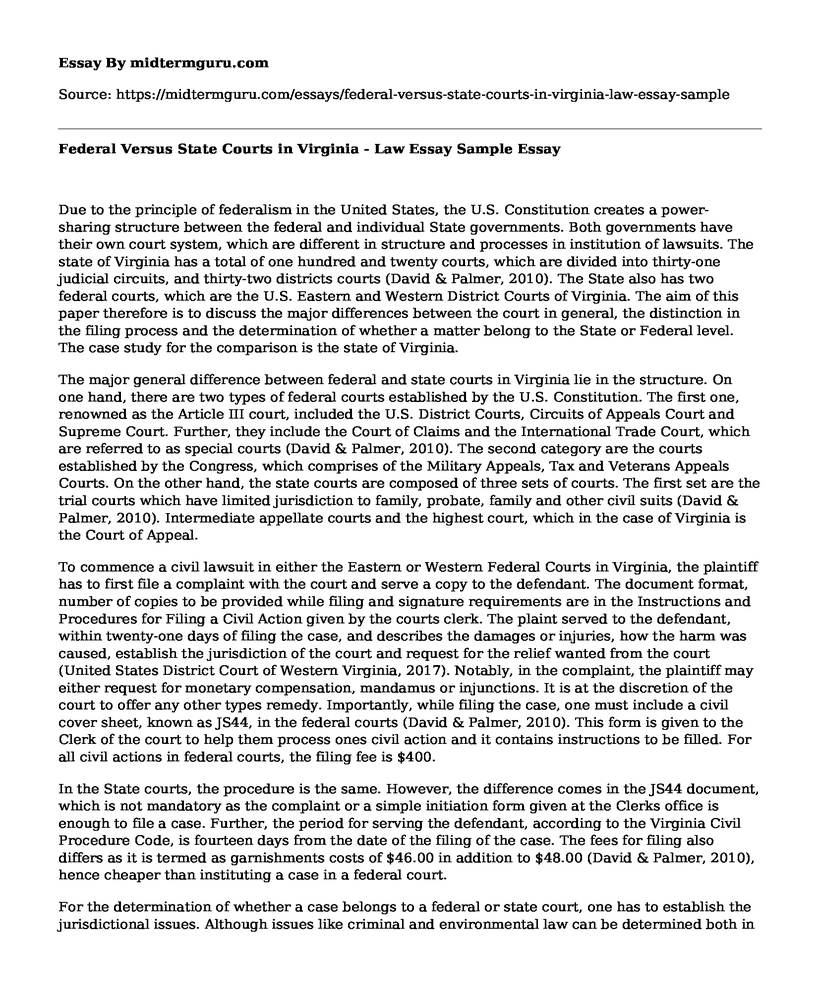Due to the principle of federalism in the United States, the U.S. Constitution creates a power-sharing structure between the federal and individual State governments. Both governments have their own court system, which are different in structure and processes in institution of lawsuits. The state of Virginia has a total of one hundred and twenty courts, which are divided into thirty-one judicial circuits, and thirty-two districts courts (David & Palmer, 2010). The State also has two federal courts, which are the U.S. Eastern and Western District Courts of Virginia. The aim of this paper therefore is to discuss the major differences between the court in general, the distinction in the filing process and the determination of whether a matter belong to the State or Federal level. The case study for the comparison is the state of Virginia.
The major general difference between federal and state courts in Virginia lie in the structure. On one hand, there are two types of federal courts established by the U.S. Constitution. The first one, renowned as the Article III court, included the U.S. District Courts, Circuits of Appeals Court and Supreme Court. Further, they include the Court of Claims and the International Trade Court, which are referred to as special courts (David & Palmer, 2010). The second category are the courts established by the Congress, which comprises of the Military Appeals, Tax and Veterans Appeals Courts. On the other hand, the state courts are composed of three sets of courts. The first set are the trial courts which have limited jurisdiction to family, probate, family and other civil suits (David & Palmer, 2010). Intermediate appellate courts and the highest court, which in the case of Virginia is the Court of Appeal.
To commence a civil lawsuit in either the Eastern or Western Federal Courts in Virginia, the plaintiff has to first file a complaint with the court and serve a copy to the defendant. The document format, number of copies to be provided while filing and signature requirements are in the Instructions and Procedures for Filing a Civil Action given by the courts clerk. The plaint served to the defendant, within twenty-one days of filing the case, and describes the damages or injuries, how the harm was caused, establish the jurisdiction of the court and request for the relief wanted from the court (United States District Court of Western Virginia, 2017). Notably, in the complaint, the plaintiff may either request for monetary compensation, mandamus or injunctions. It is at the discretion of the court to offer any other types remedy. Importantly, while filing the case, one must include a civil cover sheet, known as JS44, in the federal courts (David & Palmer, 2010). This form is given to the Clerk of the court to help them process ones civil action and it contains instructions to be filled. For all civil actions in federal courts, the filing fee is $400.
In the State courts, the procedure is the same. However, the difference comes in the JS44 document, which is not mandatory as the complaint or a simple initiation form given at the Clerks office is enough to file a case. Further, the period for serving the defendant, according to the Virginia Civil Procedure Code, is fourteen days from the date of the filing of the case. The fees for filing also differs as it is termed as garnishments costs of $46.00 in addition to $48.00 (David & Palmer, 2010), hence cheaper than instituting a case in a federal court.
For the determination of whether a case belongs to a federal or state court, one has to establish the jurisdictional issues. Although issues like criminal and environmental law can be determined both in state and federal courts, not all constitutional and civil cases can approach the federal courts at first instance. Further, the 14th Amendment of the U.S. Constitution allowed for cases in state courts to be appealed in the federal one as seen in Brown v Board of Education (David & Palmer, 2010). In spite of this, and to maintain state sovereignty, disputes between citizens of a state must begin at state courts, which are mainly governed by state law.
References
Davis, R. J., & Palmer, L. J. (2010). Handbook on the rules of civil procedure for West Virginia magistrate courts. Huntington, NY: Juris Publishing, Inc.
United States District Court of Western Virginia. (2017). How to file a Civil Complaint | Northern District of West Virginia | United States District Court. Wvnd.uscourts.gov. Retrieved 18 May 2017, from http://www.wvnd.uscourts.gov/how-file-civil-complaint
Cite this page
Federal Versus State Courts in Virginia - Law Essay Sample. (2021, Jul 01). Retrieved from https://midtermguru.com/essays/federal-versus-state-courts-in-virginia-law-essay-sample
If you are the original author of this essay and no longer wish to have it published on the midtermguru.com website, please click below to request its removal:
- Paper Example on Criminal Justice: Witness Interference
- Police Brutality Research Paper
- Paper Example on Verbal Judo in Correctional Institutions
- How Sex Workers Human Rights Are Being Violated Around the World? - Paper Example
- Dallas DA Takes Positive Step: Dismissing First-Time Marijuana Cases - Essay Sample
- Literary Analysis Essay on No Matter How Loud I Shout
- Legislation Impacting America's Education System: A Deaf Education Overview - Essay Sample







